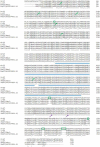Differential STAT gene expressions of Penaeus monodon and Macrobrachium rosenbergii in response to white spot syndrome virus (WSSV) and bacterial infections: Additional insight into genetic variations and transcriptomic highlights
- PMID: 34653229
- PMCID: PMC8519450
- DOI: 10.1371/journal.pone.0258655
Differential STAT gene expressions of Penaeus monodon and Macrobrachium rosenbergii in response to white spot syndrome virus (WSSV) and bacterial infections: Additional insight into genetic variations and transcriptomic highlights
Abstract
Diseases have remained the major issue for shrimp aquaculture industry for decades by which different shrimp species demonstrated alternative disease resistance or tolerance. However, there had been insufficient studies on the underlying host mechanisms of such phenomenon. Hence, in this study, the main objective involves gaining a deeper understanding into the functional importance of shrimp STAT gene from the aspects of expression, sequence, structure, and associated genes. STAT gene was selected primarily because of its vital signalling roles in stress, endocrine, and immune response. The differential gene expressions of Macrobrachium rosenbergii STAT (MrST) and Penaeus monodon STAT (PmST) under White Spot Syndrome Virus (WSSV) and Vibrio parahaemolyticus/VpAHPND infections were identified through qPCR analysis. Notably, during both pathogenic infections, MrST demonstrated significant gene expression down-regulations (during either early or later post-infection time points) whereas PmST showed only significant gene expression up-regulations. Important sequence conservation or divergence was highlighted through STAT sequence comparison especially amino acid alterations at 614 aa [K (Lysine) to E (Glutamic Acid)] and 629 aa [F (Phenylalanine) to V (Valine)] from PmST (AY327491.1) to PmST (disease tolerant strain). There were significant differences observed between in silico characterized structures of MrST and PmST proteins. Important functional differentially expressed genes (DEGs) in the aspects of stress, endocrine, immune, signalling, and structural were uncovered through comparative transcriptomic analysis. The DEGs associated with STAT functioning were identified including inositol 1,4,5-trisphosphate receptor, hsp90, caspase, ATP binding cassette transmembrane transporter, C-type Lectin, HMGB, ALF1, ALF3, superoxide dismutase, glutathione peroxidase, catalase, and TBK1. The main findings of this study are STAT differential gene expression patterns, sequence divergence, structural differences, and associated functional DEGs. These findings can be further utilized for shrimp health or host response diagnostic studies. STAT gene can also be proposed as a suitable candidate for future studies of shrimp innate immune enhancement.
Conflict of interest statement
The authors have declared that no competing interests exists.
Figures


 represents important long conserved overlaps between all sequences.
represents important long conserved overlaps between all sequences.  represents important divergent sites between PmST (cross-bred disease tolerant strain) and PmST (Accession number: AY327491.1).
represents important divergent sites between PmST (cross-bred disease tolerant strain) and PmST (Accession number: AY327491.1).  represents important divergent sites between MrST and other STAT sequences.
represents important divergent sites between MrST and other STAT sequences.  represents important amino acid addition or deletion between MrST and other STAT sequences.
represents important amino acid addition or deletion between MrST and other STAT sequences.
Similar articles
-
Transcriptome analysis reveals the regulation of the shrimp STAT on host chitin-binding domain containing proteins and energy metabolism process during WSSV infection.Fish Shellfish Immunol. 2020 May;100:345-357. doi: 10.1016/j.fsi.2020.03.026. Epub 2020 Mar 14. Fish Shellfish Immunol. 2020. PMID: 32184190
-
Molecular characterization of a novel white spot syndrome virus response protein (dubbed LvWRP) from Litopenaeus vannamei.Dev Comp Immunol. 2019 Sep;98:99-107. doi: 10.1016/j.dci.2019.04.013. Epub 2019 Apr 30. Dev Comp Immunol. 2019. PMID: 31051195
-
Two host microRNAs influence WSSV replication via STAT gene regulation.Sci Rep. 2016 Mar 31;6:23643. doi: 10.1038/srep23643. Sci Rep. 2016. PMID: 27029712 Free PMC article.
-
Signature selection forces and evolutionary divergence of immune-survival genes compared between two important shrimp species.PLoS One. 2023 Jan 12;18(1):e0280250. doi: 10.1371/journal.pone.0280250. eCollection 2023. PLoS One. 2023. PMID: 36634148 Free PMC article.
-
Immunostimulants for shrimp aquaculture: paving pathway towards shrimp sustainability.Environ Sci Pollut Res Int. 2023 Feb;30(10):25325-25343. doi: 10.1007/s11356-021-18433-y. Epub 2022 Jan 13. Environ Sci Pollut Res Int. 2023. PMID: 35025041 Free PMC article. Review.
Cited by
-
Circulating Phylotypes of White Spot Syndrome Virus in Bangladesh and Their Virulence.Microorganisms. 2022 Jan 16;10(1):191. doi: 10.3390/microorganisms10010191. Microorganisms. 2022. PMID: 35056639 Free PMC article.
References
-
- Dastidar PG, Mallik A, Mandal N. Contribution of shrimp disease research to the development of the shrimp aquaculture industry: an analysis of the research and innovation structure across the countries. Scientometrics. 2013;97(3): 659–674.
-
- FAO. The State of World Fisheries and Aquaculture 2020: Sustainability in action. Rome: FAO; 2020.
-
- Anderson JL, Valderrama D, Jory D. Shrimp production review. Global Aquaculture Alliance: Presentation Global Aquaculture Production Data and Analysis [Internet]. 2016 [cited 2021 April 9]. https://www.aquaculturealliance.org/wp-content/uploads/2018/01/Global-Sh....
-
- Thitamadee S, Prachumwat A, Srisala J, Jaroenlak P, Salachan PV, Sritunyalucksana K, et al. Review of current disease threats for cultivated penaeid shrimp in Asia. Aquaculture. 2016;452: 69–87.
-
- Ganjoor M. A short review on infectious viruses in cultural shrimps (Penaeidae family). J Fishscicom. 2015;9(3): 9–33.
Publication types
MeSH terms
Substances
LinkOut - more resources
Full Text Sources
Miscellaneous

